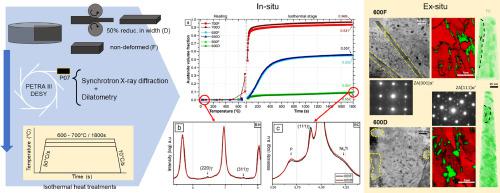当前位置:
X-MOL 学术
›
Acta Mater.
›
论文详情
Our official English website, www.x-mol.net, welcomes your feedback! (Note: you will need to create a separate account there.)
Precipitation and reverted austenite formation in maraging 350 steel: Competition or cooperation?
Acta Materialia ( IF 9.4 ) Pub Date : 2024-03-23 , DOI: 10.1016/j.actamat.2024.119865 A.L.M. Feitosa , G.G. Ribamar , J. Escobar , R. Sonkusare , T. Boll , F. Coury , J. Ávila , J.P. Oliveira , A.F. Padilha
Acta Materialia ( IF 9.4 ) Pub Date : 2024-03-23 , DOI: 10.1016/j.actamat.2024.119865 A.L.M. Feitosa , G.G. Ribamar , J. Escobar , R. Sonkusare , T. Boll , F. Coury , J. Ávila , J.P. Oliveira , A.F. Padilha

|
Aged maraging steels offer unique strength and toughness via the presence of finely dispersed precipitates, allowing the material to reach values of up to 2400 MPa in yield strength in the case of 18Ni350. However, when aging heat treatments above 550 °C are conducted, simultaneous precipitation and austenite reversion can occur changing the mechanical behavior of the material. Although many studies related to the physical metallurgy of maraging steels have already been published, less attention has been given to a detailed understanding of the initial formation of austenite and its relationship with the precipitates. In this study, undeformed and cold rolled commercial 18Ni350 maraging steel samples were submitted to short aging heat treatments of 1800s at 600, 650, and 700 °C. The influence of the initial microstructure on subsequent phase evolution was studied using synchrotron X-ray diffraction and final microstructural products using transmission electron microscopy and atom probe tomography. Results show that cold rolled samples did not present faster kinetics of transformation of reverted austenite as expected, but this condition presented austenite in a different morphology than the undeformed condition. However, cold rolling changed the morphology of reverted austenite from elongated (undeformed case) to equiaxed; and induced a higher density of smaller NiTi and FeMo precipitates, especially after low-temperature aging. Besides, the deformation extinguished retained austenite, which influenced the reverted austenite formation, concluding that the simple increase in dislocation density is not a unique and direct factor to increase the reverted austenite kinetics.
中文翻译:

马氏体时效钢 350 中的析出和回复奥氏体形成:竞争还是合作?
时效马氏体时效钢通过精细分散的沉淀物提供独特的强度和韧性,在 18Ni350 的情况下,使材料的屈服强度达到高达 2400 MPa 的值。然而,当进行高于 550 °C 的时效热处理时,可能会同时发生沉淀和奥氏体回复,从而改变材料的机械性能。尽管许多与马氏体时效钢物理冶金相关的研究已经发表,但对奥氏体的初始形成及其与析出物关系的详细了解却很少受到关注。在这项研究中,未变形的冷轧商业 18Ni350 马氏体时效钢样品在 600、650 和 700 °C 下进行了 1800 秒的短时效热处理。使用同步加速器 X 射线衍射研究了初始微观结构对后续相演化的影响,并使用透射电子显微镜和原子探针断层扫描研究了最终微观结构产品。结果表明,冷轧样品并未像预期那样表现出更快的回复奥氏体转变动力学,但这种条件下呈现出与未变形条件不同的形态的奥氏体。然而,冷轧将回复奥氏体的形态从拉长(未变形情况)改变为等轴;并诱导较小的 NiTi 和 FeMo 沉淀物密度较高,特别是在低温老化后。此外,变形消除了残余奥氏体,影响了回复奥氏体的形成,得出结论:位错密度的简单增加并不是增加回复奥氏体动力学的唯一且直接的因素。
更新日期:2024-03-23
中文翻译:

马氏体时效钢 350 中的析出和回复奥氏体形成:竞争还是合作?
时效马氏体时效钢通过精细分散的沉淀物提供独特的强度和韧性,在 18Ni350 的情况下,使材料的屈服强度达到高达 2400 MPa 的值。然而,当进行高于 550 °C 的时效热处理时,可能会同时发生沉淀和奥氏体回复,从而改变材料的机械性能。尽管许多与马氏体时效钢物理冶金相关的研究已经发表,但对奥氏体的初始形成及其与析出物关系的详细了解却很少受到关注。在这项研究中,未变形的冷轧商业 18Ni350 马氏体时效钢样品在 600、650 和 700 °C 下进行了 1800 秒的短时效热处理。使用同步加速器 X 射线衍射研究了初始微观结构对后续相演化的影响,并使用透射电子显微镜和原子探针断层扫描研究了最终微观结构产品。结果表明,冷轧样品并未像预期那样表现出更快的回复奥氏体转变动力学,但这种条件下呈现出与未变形条件不同的形态的奥氏体。然而,冷轧将回复奥氏体的形态从拉长(未变形情况)改变为等轴;并诱导较小的 NiTi 和 FeMo 沉淀物密度较高,特别是在低温老化后。此外,变形消除了残余奥氏体,影响了回复奥氏体的形成,得出结论:位错密度的简单增加并不是增加回复奥氏体动力学的唯一且直接的因素。



























 京公网安备 11010802027423号
京公网安备 11010802027423号